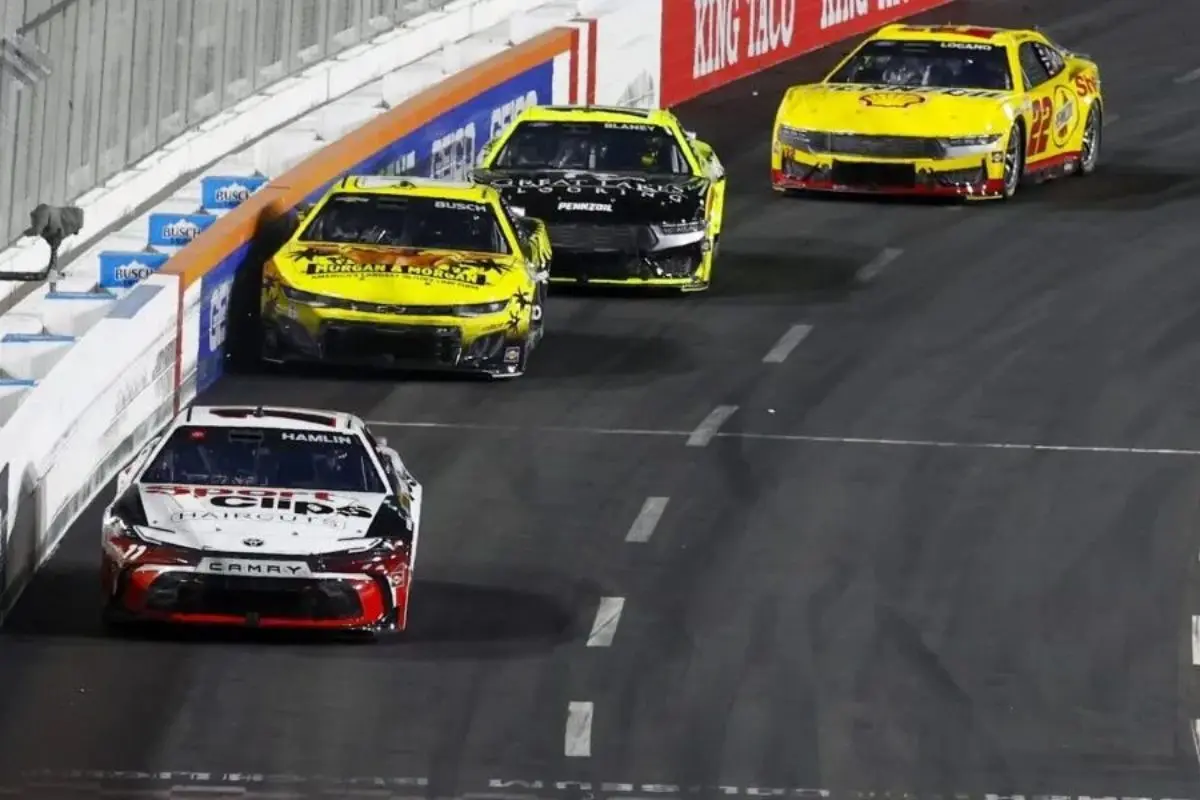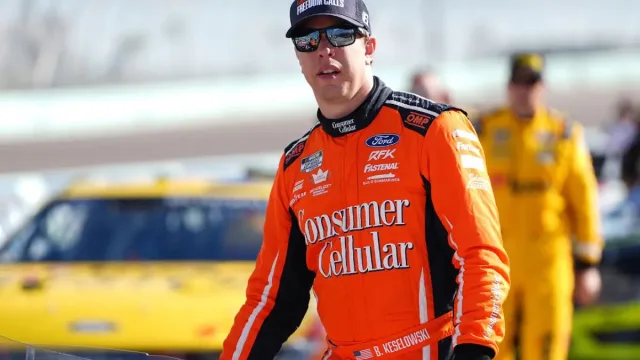Brad Keselowski‘s reaction to NASCAR’s ‘Backstory’ has caught the attention of fans everywhere. As a driver with deep ties to the sport, Brad Keselowski’s thoughts on a newly released film offer a rare behind-the-scenes look. The film highlights a significant chapter in NASCAR’s history, showing a side of racing many don’t often see. With this footage now available, Brad Keselowski’s excitement and the story it reveals might change the way fans view the sport forever.
Key Highlights
- Brad Keselowski’s documentary showcases rare, unseen footage highlighting the mechanical challenges of high-speed NASCAR racing.
- The documentary provides insight into the intricate demands of navigating NASCAR cars before horsepower reductions.
- Keselowski’s perspective emphasizes the competitive edge provided by historical high-powered engines in NASCAR.
- The footage reveals the formidable nature of NASCAR’s past racing machines, offering a nostalgic view of the sport’s evolution.
- Viewers gain an appreciation for the raw speed and performance focus that characterized NASCAR’s earlier racing dynamics.
NASCAR’s Shift in Horsepower and Speed Limits
Nostalgia often colors the way NASCAR enthusiasts view the evolution of the sport, particularly in relation to changes in horsepower and speed limits. Fans remember a time when the roar of engines with 750 horsepower dominated the tracks, a proof of the raw power and thrill of racing.
However, NASCAR’s decision to reduce engine power to 550 horsepower marked a considerable shift, altering the dynamics of the sport. This change aimed to improve safety by controlling the blistering speeds that had become a hallmark of NASCAR events.
While this move prioritized the well-being of drivers, it also sparked debates among purists who cherished the unfettered speed of earlier races. Brad Keselowski‘s recent documentary highlights the gripping nature of those pre-reduction races, where cars seemed to dance effortlessly on the asphalt.
The footage serves as a poignant reminder of an era where horsepower reigned supreme, capturing the essence of NASCAR’s thrilling past.
 Cook Out Clash Full Entry List” width=”1200″ height=”800″ srcset=”https://slicksandsticks.com/wp-content/uploads/2025/01/2025-Cook-Out-Clash-Full-Entry-List.webp 1200w, https://slicksandsticks.com/wp-content/uploads/2025/01/2025-Cook-Out-Clash-Full-Entry-List-300×200.webp 300w, https://slicksandsticks.com/wp-content/uploads/2025/01/2025-Cook-Out-Clash-Full-Entry-List-1024×683.webp 1024w, https://slicksandsticks.com/wp-content/uploads/2025/01/2025-Cook-Out-Clash-Full-Entry-List-768×512.webp 768w, https://slicksandsticks.com/wp-content/uploads/2025/01/2025-Cook-Out-Clash-Full-Entry-List-630×420.webp 630w, https://slicksandsticks.com/wp-content/uploads/2025/01/2025-Cook-Out-Clash-Full-Entry-List-150×100.webp 150w, https://slicksandsticks.com/wp-content/uploads/2025/01/2025-Cook-Out-Clash-Full-Entry-List-696×464.webp 696w, https://slicksandsticks.com/wp-content/uploads/2025/01/2025-Cook-Out-Clash-Full-Entry-List-1068×712.webp 1068w” sizes=”auto, (max-width: 1200px) 100vw, 1200px” />
Cook Out Clash Full Entry List” width=”1200″ height=”800″ srcset=”https://slicksandsticks.com/wp-content/uploads/2025/01/2025-Cook-Out-Clash-Full-Entry-List.webp 1200w, https://slicksandsticks.com/wp-content/uploads/2025/01/2025-Cook-Out-Clash-Full-Entry-List-300×200.webp 300w, https://slicksandsticks.com/wp-content/uploads/2025/01/2025-Cook-Out-Clash-Full-Entry-List-1024×683.webp 1024w, https://slicksandsticks.com/wp-content/uploads/2025/01/2025-Cook-Out-Clash-Full-Entry-List-768×512.webp 768w, https://slicksandsticks.com/wp-content/uploads/2025/01/2025-Cook-Out-Clash-Full-Entry-List-630×420.webp 630w, https://slicksandsticks.com/wp-content/uploads/2025/01/2025-Cook-Out-Clash-Full-Entry-List-150×100.webp 150w, https://slicksandsticks.com/wp-content/uploads/2025/01/2025-Cook-Out-Clash-Full-Entry-List-696×464.webp 696w, https://slicksandsticks.com/wp-content/uploads/2025/01/2025-Cook-Out-Clash-Full-Entry-List-1068×712.webp 1068w” sizes=”auto, (max-width: 1200px) 100vw, 1200px” />
The Ongoing Horsepower Debate
While the roar of high-powered engines has long been a staple of NASCAR, the ongoing horsepower debate remains a contentious issue among drivers and officials likewise.
Drivers, passionate about the sport’s legacy, often advocate for enhancing horsepower, arguing that it boosts the thrill and skill involved in racing. A powerful engine not only symbolizes the sport’s rich history but also challenges the driver’s skill on the track.
However, NASCAR officials counter that increasing horsepower would greatly inflate costs, potentially alienating new engine manufacturers considering entry into the NASCAR domain.
Historically, horsepower has dwindled from 1000 hp to a current limit of 670 hp with next-gen cars, reflecting NASCAR’s cautious approach.
Veteran driver Brad Keselowski has highlighted horsepower’s importance, hinting at its potential to redefine the sport’s competitive edge.
“So cool, great find! Backstory on this, I was filming something for the speed channel and saw the president (Hunter) in the hallway. After a brief conversation, I asked him if one day he could show qualifying from an Incar camera to shake it up a little. He didn’t say much but sure enough, a week or two later there it was…” – Brad Keselowski
So cool, great find!
Backstory on this, I was filming something for the speed channel and saw the president (Hunter) in the hallway. After a brief conversation, I asked him if one day he could show qualifying from an Incar camera to shake it up a little. He didn’t say much but… https://t.co/RQXS9EmTmf
— Brad Keselowski (@keselowski) January 28, 2025
Brad Keselowski’s Documentary and Perspective
Brad Keselowski highlight the rarity of the footage, pointing out its importance in illustrating the mechanical challenges that drivers face. He emphasized how this rare perspective captures the intensity of the sport, offering a deeper understanding of the work behind the scenes.
The documentary gives viewers a rare, immersive experience of what it’s like to navigate high-speed NASCAR cars. It dives into the complexities of the sport, providing a firsthand look at the pressure and precision required to handle these powerful machines during each race.
Keselowski expressed his gratitude for the footage’s public release, recognizing its role in showcasing the challenges drivers face. By shedding light on the mechanical intricacies of NASCAR cars, it highlights the formidable nature of the sport during a pivotal period in its history.
“So glad this film exists now in public forum as everyone can now see how these cars were real beasts to drive, especially qualifying at Charlotte motor speedway. This may be the only existing full lap onboard of qualifying from that era.” – Brad Keselowski

Drivers Advocate for More Horsepower
In the world of NASCAR, a growing number of drivers are advocating for an increase in horsepower to recapture the sport’s original thrill and excitement. Denny Hamlin, Joey Logano, and Tyler Reddick have been vocal proponents of this change, believing that more horsepower can improve the competitiveness on the track.
Hamlin argues that increased horsepower forces drivers to let off the gas sooner, creating more opportunities for tactical overtaking. He suggests even a modest increase, such as 50 horsepower, can enhance passing dynamics.
”The more you can get us out of the gas, which means if we have more horsepower, we have to let off sooner, that gives us the opportunity to overtake for the cars behind. Fifty horsepower, while it may not be a game changer, any horsepower gain will be an advantage for passing” – Denny Hamlin
Reddick’s experiment with a 150 horsepower increase during a practice session illustrated that a considerable increase is necessary to truly impact race dynamics, positing a threshold of around 1000 horsepower for noticeable change.
“A couple of months ago just for fun I asked some of the guys at 23XI. There is a weird knob we can work on to basically increase the power of the car by 150 horsepower. Didn’t really change it much. I think you’d need to be above 1000 horsepower to like, really move that needle.” – Tyler Reddick
This discussion reflects a broader desire among drivers to reinvigorate NASCAR with the raw power that once defined the sport, aiming to bring back the excitement that captivated fans in its early days.
Fans Nostalgic for NASCAR’s Raw Speed
As drivers like Denny Hamlin and Tyler Reddick champion the call for increased horsepower on the track, a parallel sentiment echoes through the NASCAR fan community, longing for the raw speed and simplicity of earlier days.
Fans reminisce about the era when high-powered engines dominated, and weekends were dedicated to practice, qualifying, and racing. A nostalgic fan remarked on missing the thrill of watching races from 1978 onward, emphasizing the importance of a full weekend’s racing experience.
“I know lot drivers dont like it, but I miss the days where after a work week, I come home and know a full weekend of practice, qualifying and racing was set for my weekend. Speed channel gone and they even took race hub. Very grateful, that I got to watch racing from 1978 on up.”
“Bring back weekend practice and qualifying, and 950hp.”
“Qualifying in those days, especially at Charlotte looked like a very tense, hold your breath deal.” – NASCAR fans reaction
The overwhelming fan support for Brad Keselowski’s sentiment reveals a deeper yearning for:
- Reinstating full weekend schedules: Including practice and qualifying, enhancing the anticipation and excitement.
- Reviving high-horsepower engines: Fans believe this would restore the visceral thrill of the sport.
- Preserving the essence of racing: Beyond coverage, fans desire a focus on performance.

News in Brief: Brad Keselowski’s Reaction to NASCAR’s ‘Backstory’
Brad Keselowski’s revelation of previously unseen NASCAR footage invites a fresh perspective on the sport, emphasizing the evolving dynamics between horsepower, speed regulations, and driver advocacy. As debates continue over the balance between safety and the sport’s thrilling roots, Keselowski’s documentary highlights a yearning for the raw power that once defined NASCAR.
This nostalgic call for more horsepower resonates with both drivers and fans, illustrating a shared desire to preserve the exhilarating essence of racing while adapting to modern demands.
ALSO READ: When Brad Keselowski Opened Up About His Racing Purpose and Desire to Be in Victory Lane
